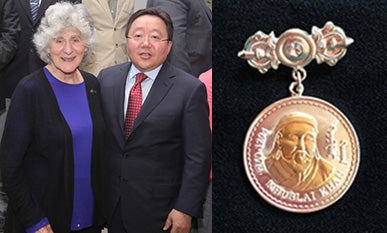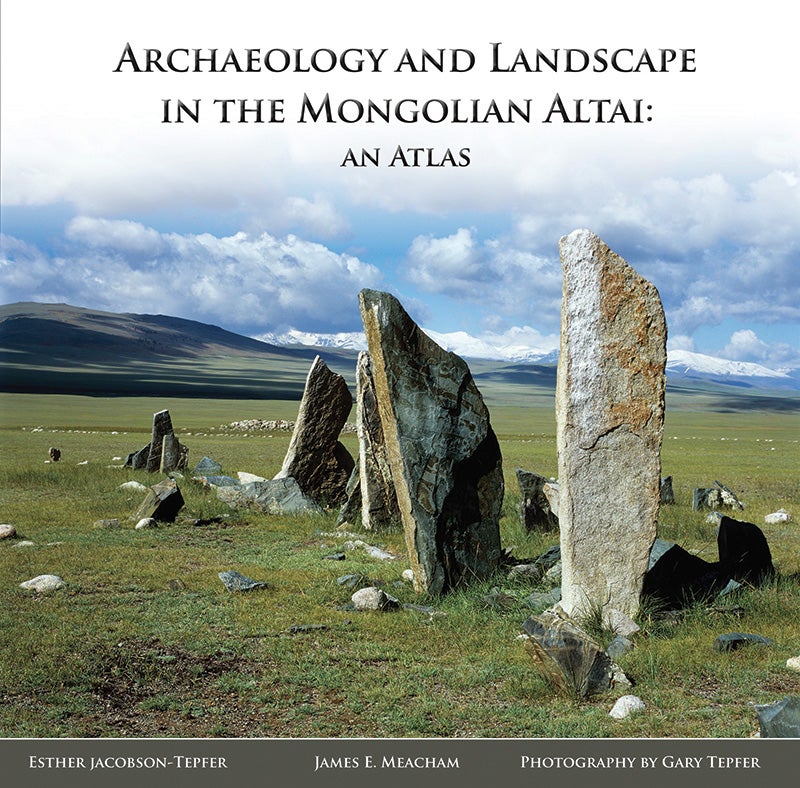Esther Jacobson-Tepfer, professor emerita and international scholar, always finds surprises when she travels to Mongolia. This time she was honored with two lifetime achievement awards by the President of Mongolia and the Mongolian Academy of Sciences for her work.

Above left: Esther Jacobson-Tepfer and Mongolian President Tsakhiagiin Elbegdorj in Ulaanbaatar, Mongolia. Above right: The Kublai Khan Medal, the highest honor bestowed by the Mongolian Academy of Sciences was presented to University of Oregon Professor Emerita Esther Jacobson-Tepfer in May 2016.
Jacboson-Tepfer received the Kublai Khan Gold Medal, the highest honor offered by the Mongolian Academy of Sciences, presented by Dr. Dorj Regdel from the Academy, and a Presidential Citation, by Mongolian President Tsakhiagiin Elbegdorj, in recognition of her work on the preservation of Mongolia's cultural heritage. The Academy’s award was presented at the international conference on May 31, "Rock Art: History, Memory, and Dialogue" under the auspices of the President of Mongolia and UNESCO.
An Asian art historian and the Maude I. Kerns Professor Emerita of Asian Art at the UO, Jacobson-Tepfer began field research in 1994 in Mongolia's Altai Mountains, the highest landscape in Mongolia, home to hunters and herders since the Bronze Age.
She’s studied the country’s mountain ranges and steppes and has completed the most comprehensive documentation of the ancient rock art sites and surface archaeology left by the early nomadic people of northwestern Mongolia.
“Our projects involved the identification and documentation of rock art and other surface monuments,” explains Jacobson-Tepfer. “In the second project, we undertook to record this material and understand its relationship to the landscape using detailed mapping of a largely unmapped area.”
The award from the Mongolian Academy of Sciences was in recognition of her efforts to preserve Mongolia's cultural heritage. In addition to her original work on Altai archaeology and landscape, Jacobson-Tepfer collaborated over a period of several years with the Mongolian government on the successful nomination of two large UNESCO World Heritage Sites: the Petroglyphic Complexes of the Mongolian Altai (2011) and the Burkhan Khaldun Mountain and Surrounding Sacred Landscape (2015).
Her first project involved collaborations with Russian and Mongolian colleagues. The second phase of the project involved James Meacham, Director of the University’s InfoGraphics Lab, and Gary Tepfer, photographer.
Professor Jacobson-Tepfer has published many refereed articles and eight books. Her book Archaeology and Landscape in the Mongolian Altai: an Atlas, produced with James Meacham and Gary Tepfer was awarded the 2010 Globe Book Prize by the Association of American Geographers, and received a CaGIS Honorable Mention for the best atlas published that year.

Above: James Meachem and Esther Jacobson-Tepfer in the Altai Mountains at Tsagaan Gol river valley in 2004 as they were conducting research to produce their award winning book, Archaeology and Landscape in the Mongolian Altai: an Atlas. Photograph by Gary Tepfer.

